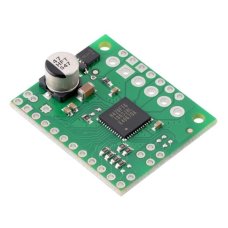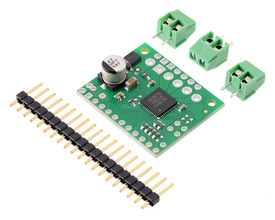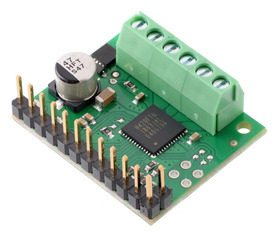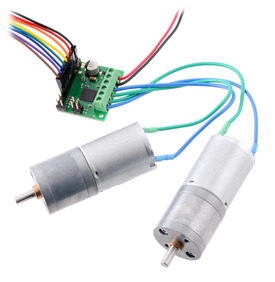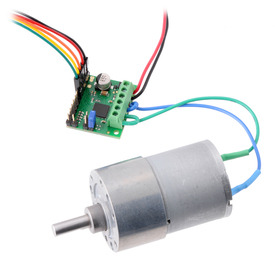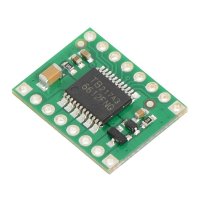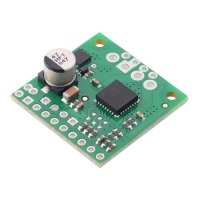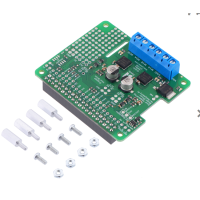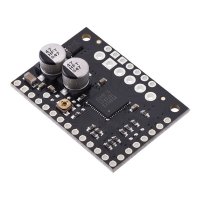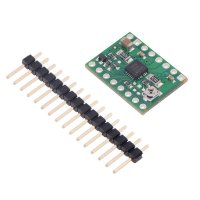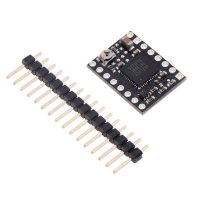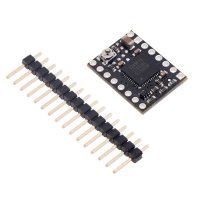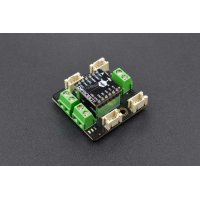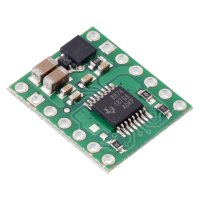The TB67H420FTG from Toshiba is an H-bridge motor driver IC that can be used for bidirectional control of one or two brushed DC motors at 10 V to 47 V. It can supply up to about 1.7 A continuously to each of two separate motors or about 3.4 A to a single motor, and it can tolerate peak currents up to 4.5 A per channel (dual) or 9 A (single) for a few seconds, making it a good choice for small- to medium-sized motors that run at higher voltages. The TB67H420FTG is a great IC, but its small surface-mount package makes it difficult for the typical student or hobbyist to use; our breakout board makes it easy to use with standard solderless breadboards and 0.1″ perfboards. Since this board is a carrier for the TB67H420FTG, we recommend careful reading of the TB67H420FTG datasheet (460k pdf). The board ships populated with SMD components, including the TB67H420FTG and a reverse battery protection circuit.
Features:
Note: the motor supply capacitors on this carrier are rated for 50 V; this is less margin than on most of our motor driver carriers, which have ICs with ratings of 40 V or less. Please keep this in mind if you want to push the high-voltage limit of this driver.
Included hardware:
This product ships with all surface-mount components—including the TB67H420FTG driver IC—installed as shown in the product picture. However, soldering is required for assembly of the included through-hole parts: one 1×20-pin breakaway 0.1″ male header and three 2-pin, 3.5 mm terminal blocks (for board power and motor outputs).
The 0.1″ male header can be broken or cut into smaller pieces as desired and soldered into the smaller through-holes. These headers are compatible with solderless breadboards, 0.1″ female connectors, and premium and pre-crimped jumper wires. The terminal blocks can be soldered into the larger holes to allow for convenient temporary connections of unterminated power and motor wires (see our short video on terminal block installation). You can also solder your motor leads and other connections directly to the board for the most compact installation.
|
|
Using the motor driver:
Motor and power connections are made on one side of the board and control connections are made on the other. The driver requires an operating voltage between 10 V and 47 V to be supplied to the power input, VIN. This input is reverse-protected up to 40 V, and the VM pin provides convenient access to the reverse-protected supply voltage.
In a typical application, three connections are used to control each motor driver channel: INx1 and INx2 to set the motor direction and PWMx to set the speed, resulting in drive-brake operation. The following simplified truth table shows how the driver operates with this control method:
| TB67H420FTG simplified truth table | |||||
|---|---|---|---|---|---|
| Inputs | Outputs | Operation | |||
| INx1 | INx2 | PWMx | x+ | x− | |
| 1 | 0 | PWM | PWM (H/L) | L | forward/brake at speed PWM % |
| 0 | 1 | L | PWM (H/L) | reverse/brake at speed PWM % | |
| 1 | 0 | 0 | L | L | brake low (outputs shorted to ground) |
| 0 | 1 | ||||
| 1 | 1 | X | |||
| 0 | 0 | X | Z | Z |
coast (outputs floating/disconnected) (standby if all IN and PWM inputs are low) |
Note the special case when all six control inputs (INA1, INA2, PWMA, INB1, INB2, and PWMB) are low: this puts the driver into a lower-power standby mode and clears any active errors.
Alternatively, the control lines can be reduced to two pins per channel if PWM signals are applied directly to INx1 and INx2 with PWMx held high; this allows either drive/brake or drive/coast operation, depending on whether the non-PWMed input is held high or low, respectively. (Note that achieving drive/brake operation with this method requires inverted PWM signals; that is, with one IN pin PWMed and the other held high, the motor will drive while the PWM signal is low and brake while it is high.) The complete truth table below shows all possible combinations of the inputs and the driver outputs they produce:
| TB67H420FTG complete truth table | |||||
|---|---|---|---|---|---|
| Inputs | Outputs | Operation | |||
| PWMx | INx1 | INx2 | x+ | x− | |
| 0 | 0 | 0 | Z | Z |
coast (standby if all IN and PWM inputs are low) |
| 1 | 0 | L | L | brake low | |
| 0 | 1 | ||||
| 1 | 1 | ||||
| 1 | 0 | 0 | Z | Z | coast |
| 1 | 0 | H | L | forward | |
| 0 | 1 | L | H | reverse | |
| 1 | 1 | L | L | brake low | |
By default, the TB67H420FTG runs in dual-channel mode and drives two motors independently, but it can optionally be configured to run in a paralleled single-channel mode, in which it can deliver about twice the current to a single motor. To select single-channel mode, connect the HBMODE pin to a logic high voltage; the adjacent VCC pin provides a convenient place to do so, either with a short piece of wire or with male header pins and a 0.1″ shorting block.
In single-channel mode, the A+ and A− pins should be connected to form one motor output, and B+ and B− should be connected to form the other. The A inputs control the motor and the B inputs are not used; the driver enters standby mode when all three A control inputs are low.
|
|
The TB67H420FTG can detect several fault (error) states that it reports by driving one or both of the LO pins low (the datasheet describes what each combination of LO1 and LO2 means). Otherwise, these pins are pulled up to VCC (5 V) by the board. Errors are latched, so the outputs will stay off and the error flag(s) will stay asserted until the error is cleared by toggling standby mode or disconnecting power to the driver.
Pinout:
Pololu 2999 TB67H420FTG Dual/Single Motor Driver Carrier
- Brand: Pololu
- Product Code:Pololu-TB67H420FTG-Motor-Driver-Carrier
- Reward Points:10
- Availability:In Stock
-
रo 1,067.00
- Price in reward points:1067
-
- 5 or more रo 1,016.00
- 14 or more रo 1,008.00
- 25 or more रo 965.00
- 50 or more रo 942.00
- 100 or more रo 904.00
Related Products
Pololu 713 TB6612FNG Dual Motor Driver Carrier
This tiny board is an easy way to use Toshiba’s TB6612FNG dual motor driver, which can independently..
रo 371.00 रo 421.00
Pololu 2997 TB9051FTG Single Brushed DC Motor Driver Carrier
The TB9051FTG is an H-bridge motor driver IC that can be used for bidirectional control of a single ..
रo 894.00 रo 1,016.00
Pololu 2761/2762 Dual TB9051FTG Motor Driver for Raspberry Pi Kit / Assembled
This add-on board enables a Raspberry Pi (Model B+ or newer) to drive a pair of brushed DC motors. I..
रo 1,890.00
Pololu 2973 / 2974 / 2998 Stepper Motor Driver Carrier TB67S249FTG/ TB67S279FTG/ TB67S128FTG
This breakout board makes it easy to use Toshiba’s TB67S249FTG/ TB67S279FTG microstepping bipolar st..
रo 1,099.00
Pololu 2878 / 2879 STSPIN820 Stepper Motor Driver Carrier
This breakout board for STMicro’s STSPIN820 microstepping bipolar stepper motor driver offers micros..
रo 1,595.00
Pololu 3098 / 3099 Stepper Motor Driver Compact Carrier TB67S279FTG
This breakout board for Toshiba’s TB67S279FTG microstepping bipoloar stepper motor driver is arrange..
रo 902.00
Pololu 3096 / 3097 Stepper Motor Driver Compact Carrier TB67S249FTG
This breakout board for Toshiba’s TB67S249FTG microstepping bipoloar stepper motor driver is arrange..
रo 969.00 रo 1,101.00
Gravity: 2x1.2A DC Motor Driver with Gravity Connector - TB6612FNG
This DFRobot micro dual way DC motor driver with Gravity connector. It is design based on TB6612FNG ..
रo 661.00 रo 762.00
Pololu 4035/4036/4037 Single Brushed DC Motor Driver Carrier DRV8874/DRV8876/DRV8876 (QFN)
This compact breakout board for TI’s DRV8874/DRV8876/ DRV8876 (QFN)motor driver offers a wide o..
रo 446.00 रo 507.00
Tags: Pololu, TB9051FTG, Single, Brushed, DC, Motor, Driver, Carrier

